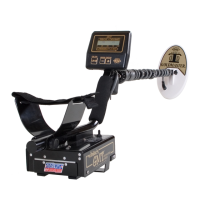Any mode or control setting allowing total acceptance of all metal types, iron, aluminum, tin,
nickel, gold, brass, lead, copper, silver etc.
Circuitry which produces different audio tones (pitch) for different target's conductivity.
One of the most extreme components of non-conductive, negative ground minerals. Mag-
netic. Also called Magnetite (Fe304) or magnetic iron oxide.
Any intentionally buried or secreted hoard of valuables.
One of the major mineral types which make up the positive ground minerals. Wet
ocean salt/sand will produce a positive response due to its similar conductivity to metal.
The measure of a metal target's ability to allow eddy currents on its surface.
The greatest measure of a metal detectors ability to transmit an electromagnetic fi eld into the
Method of manually or automatically desensitizing a metal detector so that it may locate the
Circuitry which ignores or otherwise indicates, a specifi c target based on its conductiv-
A loss or increase in threshold caused by temperature, time, or battery condition.
Small circulating currents of electricity.
Descriptive of any iron or iron bearing material.
The number of complete alternating current cycles produced by the transmit oscillator per
A state of operation in which specialized circuitry can ignore the masking effect ground
minerals have over metal targets.
A rock which contains a higher concentration of mineralization than the surrounding ground.
Refers to the total volume (average) of ground penetrated by a metal detector.
Series of listings and prompts on a visual display designed to aid the operator in feature selection.
Metallic substances: iron, foil nickel, aluminum, gold, brass, copper, silver, etc.
An electronic component that can be programed to perform certain electronic functions.
Any soil containing conductive or magnetic components.
A condition of operation selected by the operator for specifi c functions.
Any mode that requires loop movement to respond to metals.
Not of iron, any metal that is not iron.
Any mode of operation that doesn't require movement of the loop to respond to metal
The length of time between eddy current generation sustained on a metals surface and the resulting
secondary electromagnetic fi eld effect on the loops receive winding.
Finding the exact center of a metal target.
An indication of a target non-acceptance by silence or a broken sound.
The measure or capacity of a metal detector to perceive changes in conductivity within the
An audio or display response alerting the operator that a target has been detected.
The ability of a metal detector to maintain smooth predictable performance.
Refers to any object that causes an audio or display indication.
Glossary

